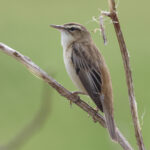Day 2 of three days of Private Tours today in Norfolk, some gentle days of general birding and other wildlife. It was another cloudy start but the cloud was slower to burn off today. We did have some nice sunny spells, particularly through the afternoon, but it was cool on the coast in the moderate NE wind.
The Peregrine was perched on the church tower again this morning as we were about to drive past, so we stopped for a closer look. It was preening at first but then stopped and turned and stared down at us. It soon lost interest in us though and went back to looking round. It was a great way to start the day.

Our first destination proper for the day was Holkham. As we set off along the path which runs on the south side of the pines, a Blackcap was singing high in one of the oaks by the path. A little further along, a Chiffchaff was singing too, but warbler song has definitely declined along here now we are into summer and the birds are busy nesting.
Not far along the path, we found our first tit flock. The Long-tailed Tits have fledged their first broods and are travelling round in big groups again, and they have already started to bring lots of other birds with them. There was a hive of activity in the trees as the tits passed through. We could hear Coal Tit and Goldcrest singing high in the pines. A Treecreeper and a Chiffchaff were with them too.
There is very little on Salts Hole at the moment, just a few Mallard, but a couple of Marsh Harriers were circling up over the reeds beyond. We heard a Green Woodpecker laughing out in the grass, and a bit further along heard a Great Spotted Woodpecker calling too, but neither were seen.

The wardens are topping the grazing meadows at the moment, and a couple of Jays were hopping around down in the cut grass. Further over, two Red Kites were following behind the tractor, presumably trying to see what was left behind after the cutting. We didn’t go into Washington Hide but had a quick look from the boardwalk. The Marsh Harriers were still circling out over the grazing marsh beyond the reeds.
As we got back down onto the path, we could hear the frenzied song of a Sedge Warbler in the reedbed. A little further on, and a Reed Warbler was singing in the reeds by the path too.
Past Meals House, we came across another tit flock. Again, there were lots of Long-tailed Tits but feeding with them we watched a family of Coal Tits, the juveniles with yellow faces. There were warblers with them too – both Chiffchaff and a Willow Warbler, feeding on the edge of the pines.
There is a great display of foxgloves under the pines at the crosstracks at the moment, which we stopped to admire on our way to Joe Jordan Hide. When we got up into the hide, there appeared to be nothing on the pool at first, but it quickly became clear that everything was hiding down at the front, behind the reeds.
Eventually a couple of Spoonbills came out into the open, an adult and a short-billed juvenile. The latter was pursuing the adult, flapping its wings and bobbing its head, demanding to be fed. Eventually the adult decided it had had enough and flew off up into the trees. Another adult Spoonbill dropped in and started feeding along the back edge of the pool, along the reeds.
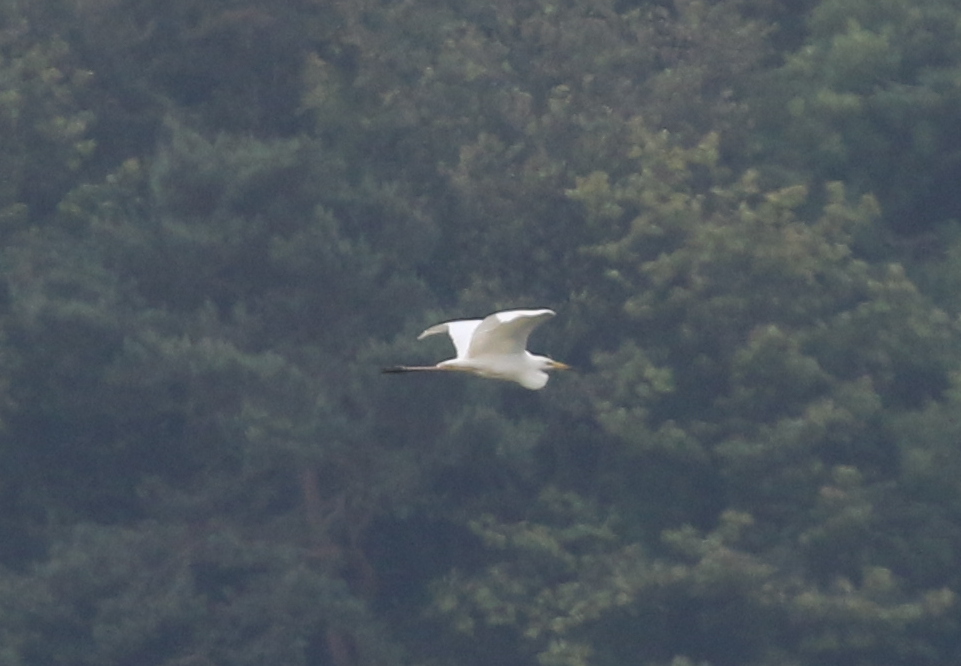
A couple of Little Egrets flew in and landed down at the front of the pool, out of view. Then a Great White Egret appeared, flying in from the east before disappearing round behind the trees. It was clearly much bigger, with long, rounded wings and slower wingbeats, long legs and a yellow-base to its bill.
There were Marsh Harriers coming and going all the time. One female did a nice pass over in front of the hide. Another, further back on the edge of the pool, appeared to still be collecting nest material. There were a couple of Common Buzzards circling in the distance and another flew out of the pines just beyond the hide and circled out over the grass in front.
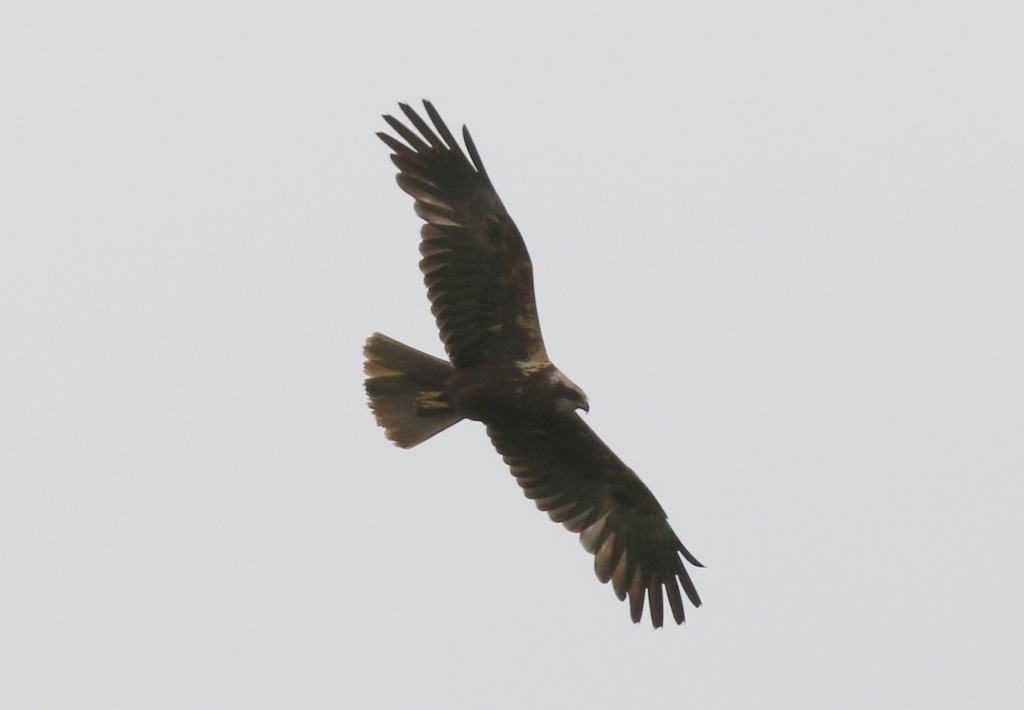
As we set off to walk back, a Siskin flew high over the pines calling. A pair of Bullfinches came out of the bushes and flew off calling round Meals House.
The sun was starting to come out now and there were noticeably more butterflies out on the way back. Several Meadow Browns and Speckled Woods fluttered over the path and a couple of Ringlet perched up nicely in the vegetation beside. A Small Skipper landed on a grass head where we could see the pale underside to its antennae. Back past Washington Hide, we sat for a minute on the bench and could see three small White-letter Hairstreaks fluttering around the tops of the elm trees opposite.
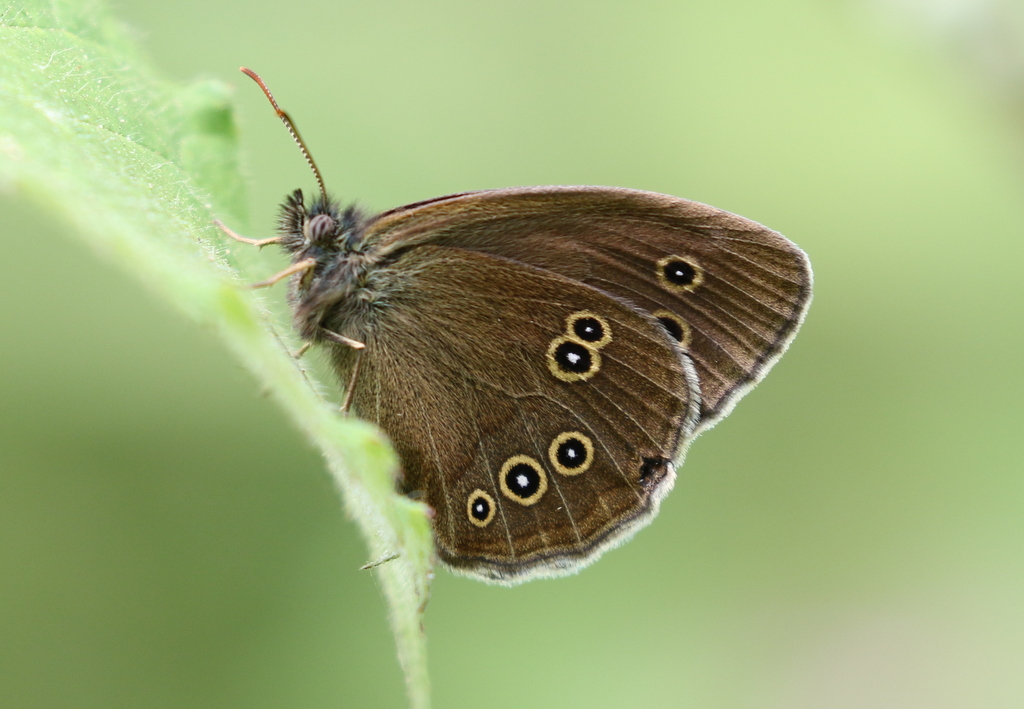
We planned to spend the afternoon at Titchwell. Over lunch at the visitor centre, we had a look to see if we could find the Tawny Owls. There has been a juvenile here for the last week or so, and often an adult too, but even though they were apparently around earlier there was no sign of them now.
After lunch, we went back to the car to get the scope and then headed out to explore the reserve. As we walked along the path beyond the visitor centre, we spotted the juvenile Tawny Owl back in the alder trees. We got it in the scope, but it flew before everyone got to see it. A minute later it then reappeared back in the alders. We got it in the scope again, but then it flew again, off towards the main path.
We walked out onto the main path and could hear the young Tawny Owl‘s begging calls from deep in the trees. It seemed there was no way to see it from here, but then it flew across the path right above our heads and landed in the tree directly above us. It perched there on a branch for some time, calling, looking down at the people passing below. We had to walk back a short way along the scope to be able to get it in the scope!
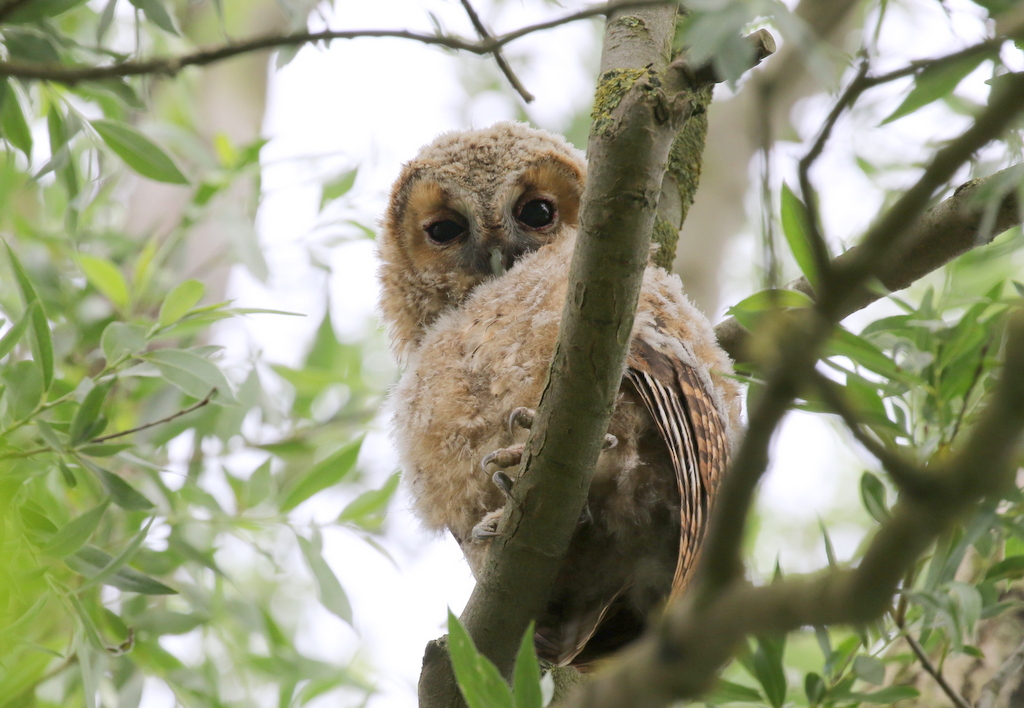
The juvenile Tawny Owl appears to be much more mobile now, than it has been. Though this may have been exacerbated this afternoon by the disappearance of the adult. The youngster was clearly looking for its parent, calling for it too. The adult Tawny Owl will return, but had possibly had enough of being pestered by its teenage offspring and gone off somewhere quiet for a rest!
Further along the path, we stopped at the reedbed pool next. Several Marsh Harriers were circling up over the reeds, including the first fledged juveniles. One adult Marsh Harrier circling higher seemed to be edging out a Kestrel, moving closer to it each time and causing it to gradually move further off.
Several Mediterranean Gulls were flying over the reeds, back and forth, calling. One Mediterranean Gull dropped in with the Black-headed Gulls to bathe on the pool. In the scope, we could see its darker, jet black hood, brighter red bill and pure white wingtips. A Reed Warbler was flitting around the edge of the pool below.

A female Red-crested Pochard was feeding its two juveniles on the edge of the reeds on the left of the reedbed pool. Then something disturbed everything and a big mob of ducks swam out from the reeds on the right. In among the Mallard, Gadwall and Common Pochard were three drake Red-crested Pochard. They are starting to moult into eclipse plumage now, but still have their bright coral-red bills. A large flock of Teal flushed from the Freshmarsh and circled over the reeds.
When we got to Island Hide, we could hear Bearded Tits calling. We looked along the edge of the reeds to see if we could find any feeding down on the mud, but it was very exposed to the cool wind on this side of the reeds today. A brief glimpse was the beat we could manage but it disappeared back deeper in before everyone could get onto it.
There were a couple of Avocets and a Black-tailed Godwit feeding in front of the hide today. There were lots of Avocets scattered across the freshmarsh, mostly sleeping on the islands, but there is still a distinct lack of juveniles here – it seems to have been a very poor breeding season for them here. There were lots more Black-tailed Godwits further over too, sleeping on the islands or in a large group in the shallow water. A couple of Ruff were asleep on the low tern island, with three or four Common Terns.

The Freshmarsh is still dominated by gulls, which have taken over the fenced-off Avocet Island. There are mostly Black-headed Gulls and a smaller number of Mediterranean Gulls. Scattered around the water, in among the other gulls, were several diminutive Little Gulls, living up to their name. They were mostly swimming today and picking insects from the water’s surface, or sleeping on the islands. We counted at least ten, all young first summer birds.

As we walked round to Parrinder Hide next, there were several more Ruff on the edge of the reeds by the junction of the paths. We stopped to look at them. Once they return from their breeding grounds, they very rapidly start to lose their ornate ruff feathers. These ones were starting to look distinctly tatty already. They were also all different colours – Ruff really are the most variable of waders!

There were lots of gulls loafing and preening on the island in front of Parrinder Hide. We had a better view of the Mediterranean Gulls from here, in direct comparison to the actually brown-headed Black-headed Gulls.
There were a few more waders here. As well as all the Black-tailed Godwits on the same island, a single Dunlin appeared on the far end of the muddy spit, still in breeding plumage and sporting a black belly patch. A Curlew dropped in – possibly a freshly returned migrant, back from the breeding grounds in Scandinavia perhaps. A large flock of Oystercatchers flew in from the beach.
There were three pairs of geese in front of the hide, and they were all different. As well as the expected Greylag Geese, a pair of Pink-footed Geese were walking around picking at the low vegetation on the island. They are common in winter here, but very unusual in summer, but on closer inspection we could see that both had damaged wings, possibly having been shot by wildfowlers and winged. They have been unable to fly back to Iceland for the breeding season, but seem to be surviving here nonetheless. A pair of Egyptian Geese flew round and showed off their striking white wing coverts.

We had a quick look from the other side of the hide, still on the Freshmarsh side. We could see a lot of waders tucked in the far corner, behind the fence. As well as more Black-tailed Godwits and Ruff, there were six Spotted Redshank. They are all still largely in breeding plumage the moment, strikingly mostly black peppered with white spots, although they are already starting to get a few paler winter feathers mixed in too.
There was nothing to see on Volunteer Marsh, and we didn’t think we could make the walk out to the beach today, after the walking we had done earlier, so we started to walk back. A Little Ringed Plover was now running around on the shore of the island, just behind the Ruff we had seen earlier.
Then it was time to head for home. More of the same tomorrow, but different!




